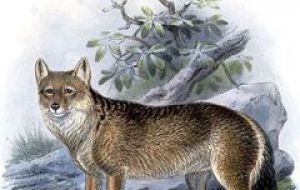MercoPress. South Atlantic News Agency
Scientists solve mystery of the extinct Falkland Islands wolf
 The canine presence in the Falklands puzzled Darwin who also forecasted their extinction
The canine presence in the Falklands puzzled Darwin who also forecasted their extinction It was an animal that puzzled Charles Darwin, who wondered how on Earth a large mammal that looked a bit like a wolf and a bit like a fox had arrived on barren islands nearly 500 kilometres from the mainland. Now, say biologists, the mystery of the now-extinct Falkland Islands wolf may have been resolved.
First spotted by Europeans in the 17th century, the wolf is -- was -- the Falklands' only native terrestrial mammal, tucking in to penguins and other small prey for its food.
Since Darwin's musings in 1834, theories have proliferated to explain how the brown-furred carnivore ended up in such a remote place. Was it brought there by Man? Had it floated over on an ice raft?
A team of scientists from Australia, Argentina and Chile have taken a crack at the riddle, the journal Nature Communications reported on Tuesday.
They teased ancient DNA out of museum specimens of Dusicyon australis and compared it with the genetic code of a similar-sized extinct mainland canine, the South American maned wolf (Dusicyon avus).
The two species have almost identical genomes, and the chronology indicates that they diverged only during the last Ice Age, which ended some 10,000-20,000 years ago, the scientists found.
At that time, global sea levels were far lower than today and the coastline of what is now southern Argentina and the eastern tip of Chile stretched much farther into the ice-bound South Atlantic.
“The Falkland Islands wolf colonised via a narrow, shallow marine strait, potentially while it was frozen over,” the study suggests.
After becoming established, the wolf became isolated when the Ice Age ended and sea levels rose, turning this distant spur of land into an archipelago. By the time Darwin saw it, the wolf was being ruthlessly hunted for its fur and to protect livestock.
Semi-tame, it would come trustingly to ranchers who would hold out a piece of meat in one hand and a knife in the other with which to stab it.
“Within a very few years after these islands shall have become regularly settled, in all probability this fox will be classed with the dodo, as an animal which has perished from the face of the Earth,” the great naturalist had written.
Within four decades, his prediction had become true. The species was wiped out in the wild in 1876, and two wolves that were shipped to London as curiosities died without offspring.




Top Comments
Disclaimer & comment rules-

-

-

Read all commentsthe wind blew them all to rgenweener with all the other flora.....................apparently
Mar 06th, 2013 - 08:17 pm 0”compared it with the genetic code of a similar-sized extinct mainland canine, the South American maned wolf (Dusicyon avus).”
Mar 06th, 2013 - 08:42 pm 0And there was me thinking they still existed in the Ibera wetlands in Argentina and in parts of Brazil!
(2) Condorito
Mar 06th, 2013 - 09:04 pm 0yet another careless English translation from our Mercopress team...
The South American maned wolf; aka Aguará Guazú, aka Chrysocyon brachyurus is NOT exctinct......
http://seancrane.com/blogphotos/maned_wolf_1x.jpg
The Dusicyon australis, Dusicyon avus and Dusicyon cultridens are.
Commenting for this story is now closed.
If you have a Facebook account, become a fan and comment on our Facebook Page!